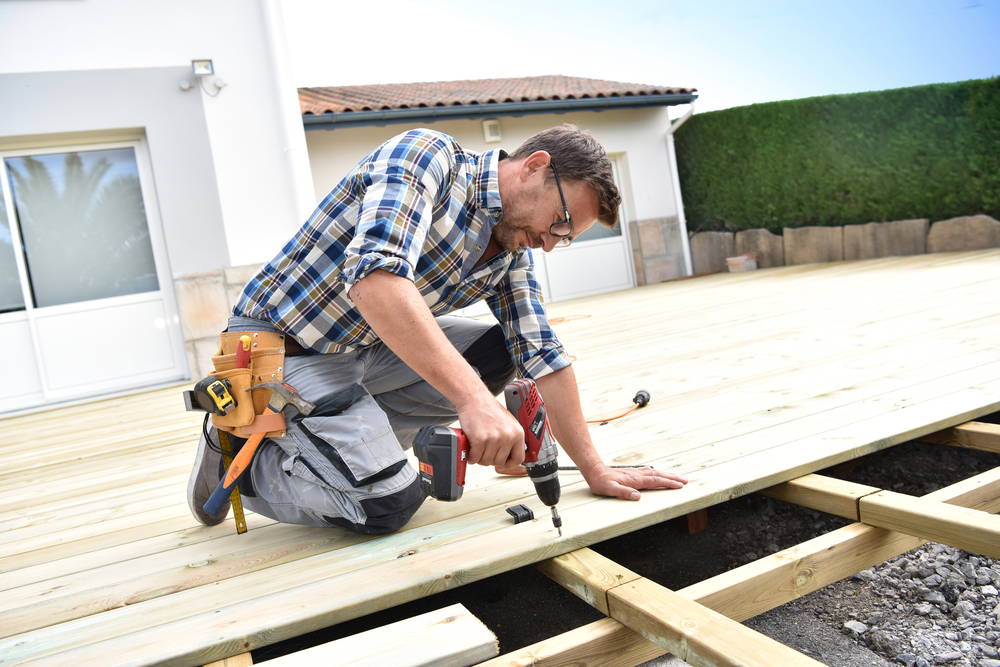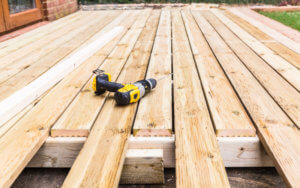A beautiful hardwood deck helps you enjoy outdoor living, mere steps outside your back door. And in the evening, it connects the warm comfort inside your home to the cool serenity of your backyard.
Eventually, deck repairs will be required, from cosmetic to structural. Fortunately, most deck problems are not structural because the underlying frame is usually built of pressure treated lumber that has chemicals to help it combat water, weather and even termites.
Some homeowners try to repair their own decks, if they have carpentry experience and the time to do it. If not, you will save time and money by hiring a qualified deck contractor. A deck pro will ensure it meets important safety requirements and will last for years to come.
Weather-beaten?
The harsh Canadian climate is very hard on your outdoor deck. Sun, rain, wind, heat, humidity and extreme cold all conspire to shorten the lifespan of your beautiful deck.
Wind and rain beat on the wood and the sun dries it out. This ongoing wet-dry cycle may cause the boards to warp and crack. When wood cracks open, water seeps into the heart of the board, where it does the most damage. When deck railings become weakened or rotten they pose a safety risk as children often climb on them and adults may lean on them. Rotten rails can break without warning, and could cause serious injury.
Repair or Replace?
When your deck starts to show signs of wear, the first question to ask is, “Should I repair or replace it?” First, examine the deck framework that is usually below the surface deck boards, not visible and in contact with the ground. Most often, the framework is built of pressure treated lumber, because it resists rot and damage from termites.
If the deck footings, posts and joists are structurally sound, but the surface boards are cracked, splintered and tired-looking, chances are you can save money by only replacing some or all of the surface deck boards and railings and attaching them to the existing framework.
What to look for:
If you’re not deck repair expert, call a local deck contractor and ask them for an inspection. Good contractors are familiar with all wood types and know how to maintain and repair them. When deciding whether to repair or replace your deck, make sure to consider:
- Sound footings. Start from the ground up by examining the footings. If your deck footings have heaved above grade, the deck will appear warped. That usually means the footings are too shallow. If so, replace them with deeper ones. Usually new footings can be dug and poured right beside the old ones, rather than ripping out the old footings, which is a big job.
- Frame material. Determine if the underlying frame is made of pressure-treated lumber or not. Treated wood, which has a light green hue, is the material used to frame most decks because it will usually last for decades. To be sure it’s treated lumber, cut a thin sliver off the end of some framing with a circular saw and look for the green tint of preservative around the edges of the cut. If a screwdriver penetrates easily, indicating rot, it’s best to rebuild your deck from scratch. And if your deck is framed with cedar or another natural wood, you should probably start over and reframe it with treated wood.
- Posts. They usually start to rot where they come in contact with the footing or ground. Ideally, posts should be installed with a bracket that holds them above grade. But if your posts are buried underground, dig down and inspect their condition.
- Structural integrity. Before starting your project, have your contractor make a drawing of your deck that lists the spans and sizes of the joists and beams. Take it to the Building Department in your municipality and ask an inspector if they are adequate. Apply for a deck building permit, and before work begins ask the inspector for an on-site opinion to confirm the structural integrity of your deck.
If you decide to repair …
If the frame is in good shape, then you must decide whether to replace all of the deck boards and railings or just a few of the most worn-out ones. If you combine new and old deck boards it will create a noticeable patchwork effect, but this will be less visible in two or three years as the new wood fades to match the old.
If you decide to rebuild …
If the underlying deck frame has rotted, you should determine the root cause of the problem (which could be drainage, plumbing or even termites) and fix it before rebuilding begins, or your new deck repair will succumb to the same problems.
Below are the average costs of Deck services across different cities in Canada:
| City | Average | Minimum | Maximum |
| Calgary | $11,533 | $100 | $50,000 |
| Edmonton | $12,474 | $1,000 | $50,000 |
| Hamilton | $13,836 | $2,500 | $45,000 |
| Oshawa | $11,450 | $500 | $50,000 |
| Ottawa | $7,965 | $350 | $28,000 |
| Toronto | $13,565 | $135 | $50,000 |
| Vancouver | $6,456 | $300 | $30,000 |
*Costs based on 1264 verified Canadian homeowner reviews as of March 2022
What about Deck Materials?
Whether you choose to repair or replace your deck, you’ll need to decide on which materials to use. This video describes the five types of deck materials and here they are, in order, from least to most expensive:
- Pressure-treated lumber. Ideal for deck framing. Treated with chemicals to resist rot and termites, which gives it a slight green hue. Least expensive.
- Cedar. Chemical free, but more susceptible to decay. Will last longer with stains and sealants applied every year or two. Ideal for extreme climates because cedar produces its own oils for years after being cut into lumber, which preserves the wood and helps maintain its distinctive cedar smell. You can protect cedar with stains or leave it unfinished to weather naturally.
- Composite*. Made from a combination of reclaimed plastic and recycled wood such as sawdust.
- Plastic*. 100% inorganic material made to look like wood. Some plastic decking is made from new plastic, while others are partially or completely recycled.
- Exotic hardwoods. Most expensive and require regular maintenance to preserve them.
* Special considerations for Composite and Plastic deck materials:
- They don’t require any maintenance or sealing, just an annual cleaning.
- They don’t rot, chip or warp and have guarantees ranging from 10 to 50 years.
- They are impervious to termites and other insects.
- They are approximately twice as expensive as wood.
- In direct sunlight, they can be very hot to walk on barefoot – but the lighter the color, the less heat they hold.
- Composite decking isn’t as stiff as lumber, so it generally needs more support to prevent sagging, which could increase your cost.
Article updated June 2022.

